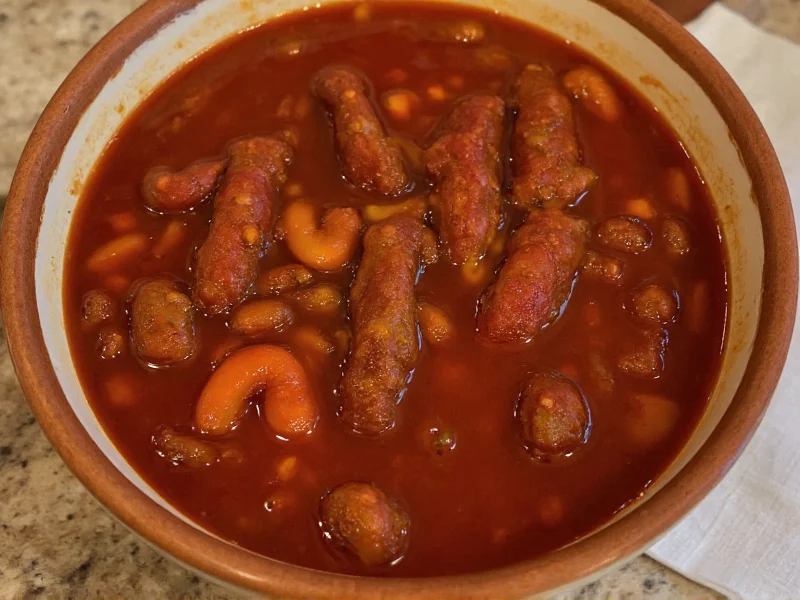If you've been searching for \"7 deep chili\" recipes or information, you're probably looking for what's commonly known as seven layer dip or seven layer chili. This beloved Tex-Mex inspired dish has become a staple at gatherings across North America, though the exact name sometimes gets mixed up in conversation.
Understanding the Seven Layer Concept
The \"seven layer\" designation refers to the distinct components that make up this crowd-pleasing dish. While variations exist, the traditional seven layer chili or dip includes:
| Layer | Typical Ingredients | Function |
|---|---|---|
| 1 | Refried beans | Base layer that holds everything together |
| 2 | Chili con carne | Meaty layer providing the chili flavor |
| 3 | Shredded cheese | Melts slightly to bind upper layers |
| 4 | Sour cream | Cooling element that balances heat |
| 5 | Guacamole or avocado | Rich, creamy texture and flavor |
| 6 | Diced tomatoes | Freshness and acidity |
| 7 | Sliced jalapeños | Additional heat and visual appeal |
Why the Confusion with \"Deep\"?
The term \"deep\" might enter the conversation when discussing chili in several contexts:
- Deep dish chili - Some restaurants offer chili in deep dish pizza-style presentations
- Deep flavor - Chefs might describe well-developed chili as having \"deep\" flavor notes
- Deep heat - Referring to intense, complex heat profiles in certain chili varieties
- Typographical errors - \"Layer\" and \"deep\" can be misheard or mistyped
Popular Variations of Seven Layer Dishes
While the traditional seven layer chili follows the structure outlined above, numerous variations have emerged:
Seven Layer Taco Salad
This version replaces the bean base with crushed tortilla chips and often includes lettuce as an additional layer. It's served as a salad rather than a dip.
Vegetarian Seven Layer Dip
Substitutes the chili con carne with vegetarian chili or additional beans, making it accessible for meat-free diets while maintaining the seven-layer structure.
Baked Seven Layer Casserole
Some recipes bake the assembled layers, transforming the dip into a more substantial casserole that holds its shape when served.
Chili Pepper Varieties for Authentic Flavor
If you're making your own chili component for seven layer dishes, understanding chili varieties can elevate your recipe:
| Chili Variety | Scoville Units | Best For |
|---|---|---|
| Ancho | 1,000-2,000 | Rich, smoky base for chili con carne |
| Guajillo | 2,500-5,000 | Adding depth and tangy notes |
| Chipotle | 2,500-8,000 | Smoky heat in moderate amounts |
| Jalapeño | 2,500-8,000 | Fresh topping layer in seven layer dip |
| Habanero | 100,000-350,000 | Extreme heat (use sparingly) |
Perfecting Your Seven Layer Chili Recipe
Whether you're preparing this for a casual get-together or a special event, these professional tips will ensure success with your seven layer chili or dip:
Layering Technique Matters
The order of layers significantly impacts both presentation and eating experience. Always start with the thickest, most substantial layer (refried beans) at the bottom, progressing to lighter toppings. This prevents heavier ingredients from sinking and muddying the distinct layers.
Temperature Control
For optimal layer definition:
- Cool your chili con carne completely before layering
- Chill the sour cream layer slightly to maintain its shape
- Assemble the dish no more than 2 hours before serving
Customization Options for Seven Layer Dishes
Personalize your seven layer chili to suit different dietary needs and preferences:
- Gluten-free: Ensure all components use gluten-free ingredients
- Dairy-free: Substitute cheese with nutritional yeast or dairy-free alternatives
- Low-sodium: Use no-salt-added beans and control seasoning
- Extra protein: Add seasoned ground turkey or beef to the chili layer
Common Mistakes to Avoid
Even experienced cooks can stumble when preparing seven layer chili. Watch out for these pitfalls:
- Overly wet ingredients - Drain tomatoes and rinse beans thoroughly
- Incorrect layer order - Heavier ingredients should be at the bottom
- Skipping the chilling time - Refrigerate for at least 30 minutes before serving
- Using pre-shredded cheese - It contains anti-caking agents that don't melt well
- Over-seasoning - Each layer should be subtly seasoned, not overpowering
Serving Suggestions for Maximum Enjoyment
Presentation significantly impacts the enjoyment of seven layer chili. Consider these serving tips:
- Use a clear glass dish to showcase the distinct layers
- Provide sturdy tortilla chips that won't break when scooping
- Offer additional toppings on the side for customization
- Pair with cold beverages to balance the heat
- Serve at room temperature for optimal flavor release
Storage and Reusability
While seven layer chili is best enjoyed fresh, you can store leftovers properly:
- Cover tightly with plastic wrap touching the surface to prevent drying
- Refrigerate for up to 3 days
- Do not freeze - the texture of dairy components will deteriorate
- Stir gently before serving leftovers as layers may blend
Seven Layer Chili for Special Occasions
This versatile dish adapts beautifully to themed gatherings:
- Sports events: Make individual portions in mason jars for easy serving
- Holiday parties: Add green ingredients for Christmas or red for Valentine's Day
- Summer barbecues: Serve alongside grilled meats as a cooling complement
- Potlucks: Bring the components separately and assemble on-site











 浙公网安备
33010002000092号
浙公网安备
33010002000092号 浙B2-20120091-4
浙B2-20120091-4